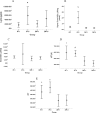The effects of dexketoprofen on endogenous leptin and lipid peroxidation during liver ischemia reperfusion injury
- PMID: 25437584
- PMCID: PMC4254237
- DOI: 10.9738/INTSURG-D-14-00121.1
The effects of dexketoprofen on endogenous leptin and lipid peroxidation during liver ischemia reperfusion injury
Abstract
Hepatic ischemia reperfusion (IR) injury has complex mechanisms. We investigated the effect of dexketoprofen on endogenous leptin and malondialdehyde (MDA) levels. Wistar albino rats were divided into 4 equal groups and were subjected to 1-hour ischemia and different subsequent reperfusion intervals. Dexketoprofen was administered in a dose of 25 mg/kg 15 minutes before ischemia induction and 1-hour reperfusion to the Dexketoprofen one-hour reperfusion group, n = 6 (DIR1) group and 6-hour reperfusion to the Dexketoprofen six-hour reperfusion group, n = 6 (DIR6) group. In the control groups, 0.9% physiologic serum (SF) was administered 15 minutes before ischemia induction and 1-hour reperfusion to the one-hour reperfusion group, n = 6 (IR1) group and 6-hour reperfusion to the six-hour reperfusion group, n = 6 (IR6) group. Although serum leptin (P = 0.044) and hepatic tissue MDA levels (P = 0.004) were significantly higher in the IR6 group than in the IR1 group, there were no significant differences in dexketoprofen pretreatment between the DIR1 and DIR6 groups. There were no differences in serum MDA levels among the 4 groups, and serum aspartate aminotransferase (AST) and alanine aminotransferase (ALT) activities were significantly higher in the IR1 (P = 0.026 and P = 0.018, respectively) and IR6 (P = 0.000 and P = 0.002, respectively) groups than in the DIR1 and DIR6 groups. Dexketoprofen pretreatment can protect the liver from IR injury by decreasing inflammation and lipid peroxidation. Our study shows that dexketoprofen has no effects on endogenous leptin during IR injury.
Keywords: Ischemia-reperfusion injury; Ketoprofen; Leptin; Liver; Malondialdehyde.
Figures


Similar articles
-
Ergothioneine pretreatment protects the liver from ischemia-reperfusion injury caused by increasing hepatic heat shock protein 70.J Surg Res. 2004 Nov;122(1):96-102. doi: 10.1016/j.jss.2004.06.016. J Surg Res. 2004. PMID: 15522321
-
Hepatic energy metabolism and the differential protective effects of sevoflurane and isoflurane anesthesia in a rat hepatic ischemia-reperfusion injury model.Anesth Analg. 2008 Mar;106(3):830-7, table of contents. doi: 10.1213/ane.0b013e3181616fc9. Anesth Analg. 2008. PMID: 18292427
-
Alpha-lipoic acid protects against hepatic ischemia-reperfusion injury in rats.Pharmacology. 2007;79(3):163-70. doi: 10.1159/000098953. Epub 2007 Jan 24. Pharmacology. 2007. PMID: 17259747
-
The effect of dexketoprofen on ischemia reperfusion injury.Bratisl Lek Listy. 2014;115(5):256-9. doi: 10.4149/bll_2014_053. Bratisl Lek Listy. 2014. PMID: 25174054
-
The protective effect of L-carnitine on hepatic ischemia-reperfusion injury in rats.Turk J Gastroenterol. 2013;24(1):51-6. Turk J Gastroenterol. 2013. PMID: 23794344
Cited by
-
From Chemistry to Pharmacology: Exploring the Anti-Inflammatory and Antioxidant Potential of Novel Dexketoprofen Amide Derivatives.Antioxidants (Basel). 2025 Jun 27;14(7):796. doi: 10.3390/antiox14070796. Antioxidants (Basel). 2025. PMID: 40722899 Free PMC article.
References
-
- Husted TL, Lentsch AB. The role of cytokines in pharmacologic modulation of hepatic ischemia/reperfusion injury. Curr Pharm Des. 2006;12(23):2867–2873. - PubMed
-
- Jaeschke H. Mechanisms of reperfusion injury after warm ischemia of the liver. J Hepatobiliary Pancreat Surg. 1998;5(4):402–408. - PubMed
-
- Jaeschke H. Molecular mechanisms of hepatic ischemia-reperfusion injury and preconditioning. Am J Physiol. 2003;284(1):G15–26. - PubMed
-
- Menger MD, Vollmar B. Role of microcirculation in transplantation. Microcirculation. 2000;7(5):291–306. - PubMed
MeSH terms
Substances
LinkOut - more resources
Full Text Sources
Other Literature Sources

